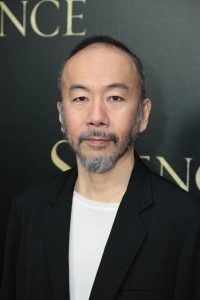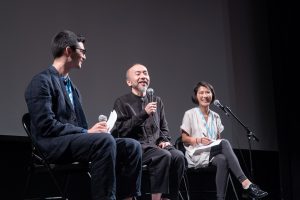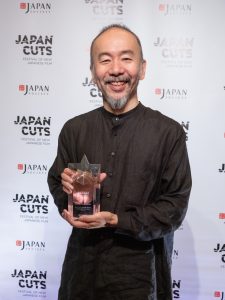JQ Magazine: JQ&A with Director Shinya Tsukamoto at JAPAN CUTS

“In the film Killing, I don’t necessarily have one political message that’s strongly pursued, and I want the audience to figure out the film’s message for themselves. Personally speaking, I find it to be incredibly frightening today of what the Japanese government is doing.” (Courtesy of Shinya Tsukamoto)
By Lyle Sylvander (Yokohama-shi, 2001-02) for JQ magazine. Lyle used to work in New York City for Merchant Ivory Productions and the National Geographic Channel. He currently teaches history, international relations and film at an international high school in Shanghai, China.
Shinya Tsukamoto is a Japanese filmmaker most famous for his Tetsuo trilogy of horror/sci-fi films: Tetsuo: The Iron Man (1989), Tetsuo II: Body Hammer (1992), and Tetsuo: the Bullet Man (2009). Other films include Hiruko the Goblin (1991), Bullet Ballet (1998), and Tokyo Fist (1995). He has also acted in most of his own films as well as those of others, most recently in Martin Scorsese’s Silence (2016).
Last week, Tsukamoto made a special appearance at Japan Society in New York City for their annual JAPAN CUTS film festival to receive their prestigious CUT ABOVE Award for Outstanding Achievement in Film, as well as to speak at the East Coast premiere of his latest film, Killing. In this exclusive interview, JQ spoke with the director about violence and politics in his work, lifelong influences, and the story behind the name of his most enduring creation. (Translation by Aiko Masubuchi.)
You have stated that Killing was made in response to the violence you see today in society. All of your previous films have dealt with violence in one way or another—how is your position towards violence different in this film than in others?
When I was little, and for a long time, of course there were some violent things that happened in Japan, but mostly speaking, the violence was outside Japan and Japan was a country that would try to avoid war. It was that way for a long period of time. So, in my earlier films, the violence I was depicting was more fantastical. But now, times have changed: Japan is turning into a country that is getting ready to go to war, and so I could no longer depict violence through a fantastical lens—I needed to depict violence as something realistic and scary and use it as a warning, and so could no longer depict violence the same way.
Does this mean that your film is in response to the Abe administration’s recent foreign policy and re-militarization of Japan?
In the film, I don’t necessarily have one political message that’s strongly pursued, and I want the audience to figure out the film’s message for themselves. Personally speaking, I find it to be incredibly frightening today of what the Japanese government is doing.
How does your version of Nobi (Fires on the Plain) differ from Kon Ichikawa’s classic version of the same anti-war story?
I am a huge fan of Kon Ichikawa’s film Nobi, and I first saw it when I was in high school. I thought it was a fantastic anti-war statement and incredibly moving. In fact, the films I made as a teenager were greatly influenced by it. What I like about Ichikawa’s film is that he brings the camera into the internal darkness of the characters. Even though the setting of the original story is in the Philippines, Ichikawa’s film was shot in Japan. But what struck me in the original story was the beautiful nature and the landscapes of the Philippines, which contrasted the horror of what the soldiers were doing to each other. To me, it seemed important to have the Philippines’ beautiful nature as a backdrop, so the way we approached the film visually was quite different.

With Japan Society deputy director of film Kazu Watanabe and interpreter Aiko Masubuchi, New York City, July 24, 2019. (Mike Nogami)
What challenges did you face in working with your first jidaigeki (period samurai) film?
I am not very knowledgeable about the late Edo period, so I collaborated with a professor that was knowledgeable about the time period. This allowed me to approach this time period and make it more historically accurate in the film.
In terms of sword fighting, I wasn’t trying to express the beauty of sword fighting—I was trying to express the horror of cutting people down with the sword. So what I tried to express was that to feel as real as possible.
What Japanese directors do you most admire? Which foreign directors?
There are many filmmakers that I am influenced by. In terms of Japanese artists, I have to say Akira Kurosawa, Yoshihiro Tatsumi—who is less known outside Japan—and I’m very much influenced by Shohei Imamura. In terms of living foreign filmmakers, I have to say definitely Martin Scorsese and Ridley Scott, especially his Alien.
What is like being an independent filmmaker in Japan working outside the studio system?
In terms of finance, it is difficult to raise money. However, psychologically I do think it is healthy in the sense that if I write a script myself, I can start it whenever I want and I can begin right away. But at the same time, because I am not so concerned with the money side, I realize that not much money is going to my staff—but this is something I want to be more aware of moving forward.
What are your feelings about the move to digital from 16mm and 35 mm film? Do you like working in and viewing films in digital?
Because I am making films with very little money, I switched to digital about 15 years ago because it is so much cheaper and the whole process from shooting to editing is much more convenient. But sometimes I have the opportunity watch movies on 16 or 35mm film, and I find it has a certain beauty that only film can express. I do find film to be great, but it’s not realistic to go back to film because of the money constraints.

With the CUT ABOVE Award for Outstanding Achievement in Film, Japan Society, New York City, July 24, 2019. (Mike Nogami)
Were you surprised that Tetsuo: The Iron Man went on to become such a big international cult film or did you feel, while you were making it, that it always had that kind of potential?
I didn’t even have the thought to bring this film abroad. At the beginning, I just hoped that the film would do well on video in Japan. So, I had no idea that it would become so big internationally.
Finally, can you confirm the rumor that you named Tetsuo after the character in Akira?
Not at first. When I was making the movie, the character didn’t have a name. Later, I thought that the name “Tetsuo” would make the character more liked by the audience, but then I remembered that there is a character named Tetsuo in Akira, so I thought that perhaps I shouldn’t use the name. Then I thought about the two films, and thought that both of these films are the children of movies like Blade Runner and David Cronenberg’s Videodrome. And so if Akira is the older brother of that lineage, then Tetsuo works as the younger brother.
Visit Shinya Tsukamoto’s homepage at http://tsukamotoshinya.net. For more JQ interviews, click here.


Comments are closed.